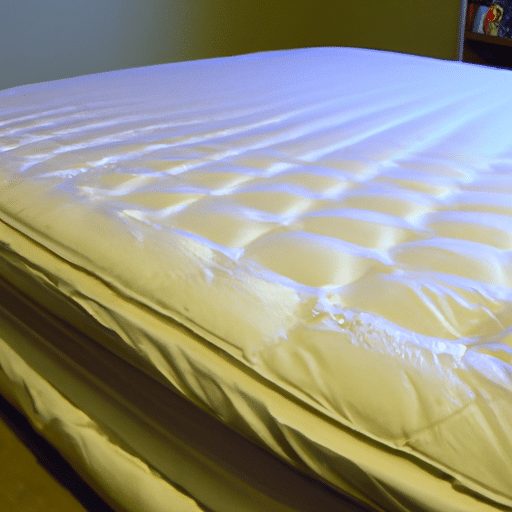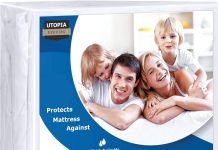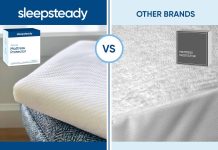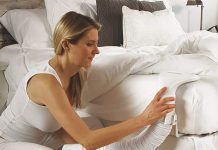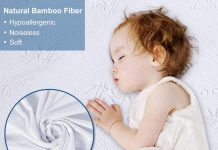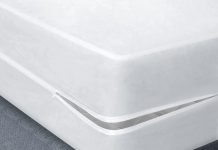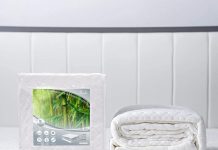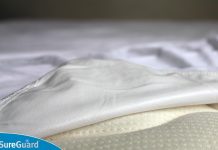Curious about the purpose and benefits of a mattress protector? Look no further! In this article, we will uncover the essence of this essential bedroom accessory. From safeguarding against spills and stains to creating a barrier against allergens and bed bugs, a mattress protector is the unsung hero of a good night’s sleep. Discover how this simple yet effective cover can not only extend the lifespan of your mattress but also improve your overall sleep hygiene. So, let’s dive into the world of mattress protectors and unlock the secrets to a cleaner, more comfortable sleeping experience.
Review contents
Definition and Purpose
A mattress protector is a bedding accessory that serves multiple purposes to ensure the longevity and cleanliness of our mattress. It acts as a barrier between the mattress and external elements, safeguarding it from wear and tear.
Protects and extends mattress lifespan
One of the primary purposes of a mattress protector is to protect and extend the lifespan of our mattress. By providing an additional layer of defense, it helps prevent damage to the mattress caused by spills, stains, or accidents, which can lead to premature deterioration. A good quality mattress protector acts as a shield, preserving the integrity of the mattress and allowing it to provide years of comfortable sleep.
Keeps mattress clean and hygienic
A mattress protector is also instrumental in keeping our mattress clean and hygienic. It acts as a barrier against dirt, dust, and allergens, preventing them from seeping into the mattress. This is especially valuable for those who suffer from allergies or asthma, as the protector can significantly reduce exposure to potential triggers that might be lurking in the mattress.
Prevents the penetration of liquids and stains
Accidental spills and stains are inevitable, whether it’s a morning cup of coffee or a glass of water knocked over. A mattress protector with waterproof or water-resistant properties can be a real lifesaver in these situations. It creates a protective barrier that prevents liquids from seeping into the mattress, keeping it safe from potential stains and odors.
Reduces allergens and dust mites
For individuals who suffer from allergies or respiratory issues, a mattress protector can be a game-changer. It creates a physical barrier that prevents allergens such as dust mites, pet dander, and pollen from settling into the mattress. By reducing the presence of these irritants, a mattress protector can help alleviate symptoms and improve sleep quality.
Types of Mattress Protectors
Mattress protectors come in various styles, each offering unique features and benefits. Here are some of the most common types:
Fitted sheet style
The fitted sheet style mattress protector is similar to a regular fitted sheet and covers the top surface of the mattress. It is designed with elasticized edges that ensure a snug fit. This style is easy to install and remove, making it convenient for regular cleaning.
Encasement style
An encasement style mattress protector covers the entire mattress, encasing it like a second skin. It provides complete protection from all sides, including the top, bottom, and sides. This style is particularly useful for those concerned about allergens, bed bugs, or a particularly delicate mattress.
Zippered style
Zippered mattress protectors are similar to encasement style protectors but feature a zipper closure. This closure ensures a secure fit and provides added protection against potential bed bug infestations. It is a popular choice for those living in areas prone to bed bug problems.
Padded style
Padded mattress protectors add an extra layer of comfort to the mattress. They are cushy and provide some level of padding between the sleeper and the mattress. This style is a good option for those looking to enhance the overall comfort of their mattress.
Features to Consider
When choosing a mattress protector, several features should be taken into consideration to ensure it meets our specific needs. Here are some key features to consider:
Waterproof or water-resistant
For those who anticipate potential liquid spills or accidents, a waterproof or water-resistant mattress protector is crucial. This feature prevents liquids from seeping through to the mattress, safeguarding it from stains and damage.
Hypoallergenic materials
If allergies or asthma are a concern, choosing a mattress protector made from hypoallergenic materials is essential. These materials are resistant to common allergens and prevent them from accumulating within the protector and aggravating allergies or respiratory issues.
Breathability
A breathable mattress protector allows air to circulate freely, ensuring a cool and comfortable sleep environment. It prevents heat and moisture buildup, reducing the risk of discomfort and unpleasant odors.
Noiseless and soft
Some mattress protectors may produce noise or be rough and uncomfortable to sleep on. Opting for a noiseless and soft protector ensures a peaceful and comfortable sleep experience.
Easy to clean
Regular cleaning is crucial to maintain the hygiene and longevity of a mattress protector. Choosing a protector that is easy to clean, either by machine washing or spot cleaning, will make the maintenance process hassle-free.
Secure fit
A properly fitting mattress protector is essential to ensure it stays in place throughout the night. Look for a protector with elasticized edges or a secure closure system to guarantee a snug and secure fit.
Benefits of Using a Mattress Protector
Using a mattress protector offers several benefits beyond protecting the mattress itself. Let’s explore some of these advantages:
Enhances mattress durability
By shielding the mattress from stains, spills, and other potential damage, a mattress protector significantly extends its lifespan. This can save us money in the long run, as we won’t need to replace the mattress as frequently.
Improves sleep quality
A clean and hygienic sleep environment is essential for a restful sleep. With a mattress protector, we can breathe easier knowing our mattress is protected from allergens and irritants. This can lead to improved sleep quality and overall well-being.
Provides allergy and asthma relief
For individuals suffering from allergies or asthma, a mattress protector can be a real game-changer. By preventing dust mites, pet dander, and other allergens from infiltrating the mattress, it reduces the potential triggers that can exacerbate symptoms. This can offer significant relief and improve the overall quality of life.
Protects against bed bugs
Bed bug infestations can be a nightmare to deal with. Using a mattress protector with a secure closure system, such as a zippered style, creates a barrier that prevents bed bugs from accessing the mattress. This added protection can provide peace of mind and help prevent infestations.
Saves time and money on mattress cleaning
Cleaning a mattress can be a time-consuming and challenging task. By using a mattress protector, we can minimize the need for deep cleaning or professional mattress cleaning services. Simply removing and washing the protector regularly will help keep the mattress clean and fresh.
How to Choose the Right Mattress Protector
Selecting the right mattress protector involves considering our specific needs and preferences. Here are some steps to guide us in choosing the perfect protector:
Consider your needs
Identify why you need a mattress protector. Whether it’s to protect against spills, allergies, bed bugs, or general wear and tear, understanding our requirements will help narrow down the options.
Determine the mattress size
Ensure you know the exact dimensions of your mattress to choose a protector that fits correctly. A well-fitting protector will provide optimal protection and maintain its position throughout the night.
Check the material construction
Different mattress protectors may be made from various materials, such as cotton, polyester, or a blend of fabrics. Consider the pros and cons of each material and select the one that suits your preferences in terms of breathability, comfort, and hypoallergenic properties.
Assess additional features
Consider additional features that might be important to you, such as waterproofing, noise reduction, or padding. These features can enhance the overall functionality and comfort of the protector.
Read customer reviews and ratings
Researching customer reviews and ratings can provide valuable insights into the performance and durability of different mattress protectors. This information can help in making an informed decision and selecting a protector with a proven track record.
How to Care for a Mattress Protector
Caring for a mattress protector properly is essential to maintain its performance and prolong its lifespan. Here are some essential care tips:
Follow manufacturer’s instructions
Always refer to the manufacturer’s instructions for specific care guidelines. Different mattress protectors may have different washing and drying instructions, so it’s important to follow them accordingly.
Regularly wash and dry
To keep the mattress protector clean and fresh, it’s recommended to wash and dry it regularly. Follow the recommended frequency specified by the manufacturer to maintain optimal hygiene.
Spot clean stains promptly
Accidents happen, and stains can occur on the mattress protector. It’s important to spot clean any stains promptly to prevent them from setting. Refer to the manufacturer’s instructions for recommended stain removal methods.
Rotate the protector periodically
To ensure even wear and tear, periodically rotate the mattress protector. This can help extend its lifespan and maintain its protective properties.
Common Misconceptions about Mattress Protectors
Despite the numerous benefits, some misconceptions exist surrounding mattress protectors. Let’s debunk a few of these myths:
Mattress protectors make noise
While older mattress protectors may have produced noise, modern designs have made significant advancements in noise reduction. Many mattress protectors are now specifically engineered to be noiseless, allowing for a quiet and undisturbed sleep.
Mattress protectors are uncomfortable
With numerous options available in the market, selecting the right mattress protector can provide optimal comfort. Look for a protector made from soft and breathable materials to ensure a comfortable sleep experience.
Mattress protectors are difficult to install
Most mattress protectors are designed for easy installation and removal. Fitted sheet style or encasement style protectors are typically straightforward to put on and take off, requiring minimal effort.
Mattress protectors are expensive
While the price of a mattress protector varies depending on the brand and features, there are options available to suit different budgets. Investing in a mattress protector can save money in the long run by extending the lifespan of the mattress and reducing the need for professional cleaning services.
Frequently Asked Questions
Here are answers to some commonly asked questions about mattress protectors:
Can a mattress protector improve mattress comfort?
While the primary purpose of a mattress protector is to protect the mattress, some designs also offer additional comfort features. Padded mattress protectors, for example, can add a layer of cushioning and enhance overall comfort.
Are mattress protectors suitable for all mattress types?
Yes, mattress protectors are generally suitable for all types of mattresses, including memory foam, innerspring, hybrid, and latex. However, it is important to check the specific guidelines and compatibility of the protector with your mattress type.
How often should a mattress protector be replaced?
The lifespan of a mattress protector depends on its quality and usage. On average, it is recommended to replace a mattress protector every 2-5 years or sooner if it shows signs of wear and tear.
Can a mattress protector cure allergies?
A mattress protector cannot cure allergies, but it can significantly reduce exposure to allergens such as dust mites, pollen, and pet dander. By creating a barrier, it can help alleviate symptoms and provide relief for allergy sufferers.
Can a mattress protector prevent bed bugs?
While no product can guarantee complete protection against bed bugs, a mattress protector with a secure closure system, such as a zippered style, can act as an additional preventive measure. It creates a barrier that makes it more challenging for bed bugs to infest the mattress.
Conclusion
A mattress protector is a crucial investment for preserving the lifespan and cleanliness of our mattress. By acting as a barrier against spills, stains, allergens, and pests, it offers numerous benefits for both our health and the longevity of our mattress. When choosing a mattress protector, considering factors such as waterproofing, material construction, and additional features can help ensure it meets our specific needs. By following proper care guidelines, we can maintain the performance and durability of the protector, allowing it to serve us well for years to come. So, whether you’re looking to enhance mattress durability, improve sleep quality, or protect against allergens, a mattress protector is a valuable addition to your bedding ensemble.

